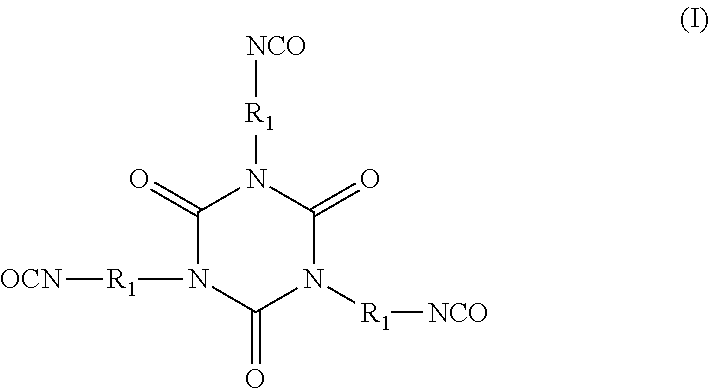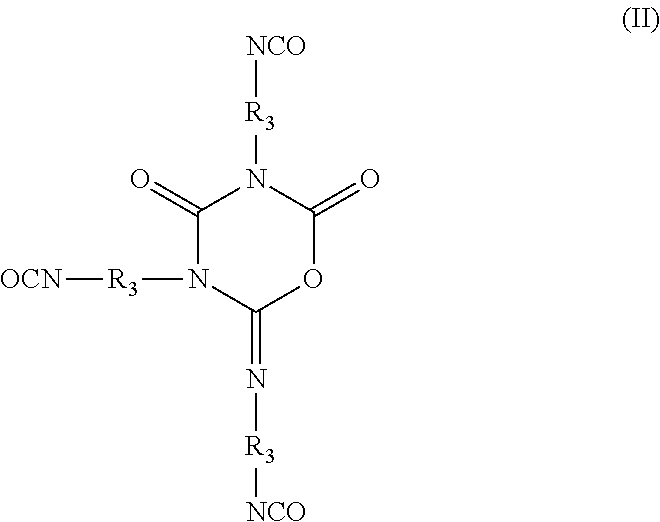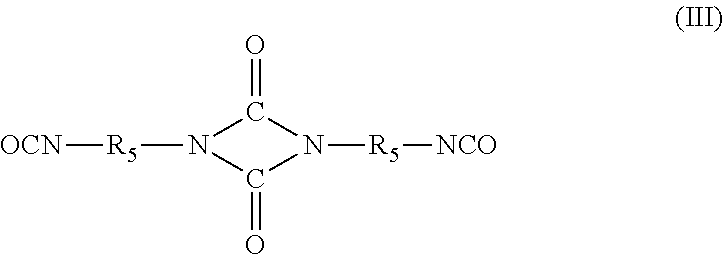Crosslinkable Moulding Composition
a crosslinking and composition technology, applied in the field of thermosetting resin composition and cured resin, can solve the problems of low strength of high crosslinking density resin, affecting the mechanical performance of the object, so as to achieve good mechanical
- Summary
- Abstract
- Description
- Claims
- Application Information
AI Technical Summary
Benefits of technology
Problems solved by technology
Method used
Image
Examples
example 1
[0292]Into a 2-litre, lidded round-bottomed flask equipped with reflux condenser, motorised anchor stirrer and temperature probe was charged 516.09 g of Vestanat 1890 / 100, 226.26 g of styrene, 0.48 g of Fascat 4202HP and a mixture of inhibitors consisting of 0.60 g of 1,4-naphthaquinone, 0.15 g of 1,4-benzoquinone and 1.8 g of Solution Q. This mixture was heated, with stirring, to a temperature between 80 and 85° C. before commencing dropwise addition of 696.94 g of Sartomer SR444D. This addition step lasted 100 minutes, the temperature being maintained between 80 and 85° C. during this time. The reaction is exothermic, so variation of the addition rate is one means by which the maintenance of a steady batch temperature may be achieved. Once this addition was complete, the reaction mixture was stirred at 80-85° C. for 30 minutes, until the isocyanate content had dropped to 1.45%. 253.21 g of glycerol dimethacrylate was then added dropwise over 45 minutes, again maintaining the tempe...
example 2
[0293]Into a 1-litre, lidded round-bottomed flask equipped with reflux condenser, motorised anchor stirrer and temperature probe was charged 212.76 g of Desmodur N3400, 112.09 g of styrene, 0.24 g of Fascat 4202HP and a mixture of inhibitors consisting of 0.30 g of 1,4-naphthaquinone, 0.075 g of 1,4-benzoquinone and 0.9 g of Solution Q. This mixture was heated, with stirring, to a temperature between 80 and 85° C. before commencing dropwise addition of 393.75 g of PETIA. This addition step lasted 70 minutes, the temperature being maintained between 80 and 85° C. during this time. Once this addition was complete, the reaction mixture was stirred at 80-85° C. for 35 minutes, until the isocyanate content had dropped to 2.00%. 126.60 g of glycerol dimethacrylate was then added dropwise over 40 minutes, again maintaining the temperature in the flask between 80 and 85° C. After completion of this addition, the mixture was stirred at 80-85° C. until the isocyanate content had dropped to 0....
examples 3-7
[0305]The two masterbatch examples above were diluted with different copolymerisable monomers, in the proportions by weight shown in Table III below, to prepare examples 3-7. The table also shows the oligomer contents of the finished resin compositions thus prepared, and the HDTs of the cured materials. These HDTs were obtained by curing the test specimens with 2% Butanox LPT plus 5% Accelerator E. After leaving overnight at room temperature, the specimens were postcured for 5 hours at 80° C. followed by 3 hours at 200° C. (i.e. Postcure A).
TABLE IIIEXAMPLE34567Masterbatch85 · 070 · 075 · 0——example M1Masterbatch———70 · 085 · 0example M2Ethylene glycol15 · 015 · 0—30 · 0dimethacrylateSartomer SR368—15 · 0———Tripropylene——15 · 0——glycoldiacrylateDivinylbenzene——10 · 0—15 · 0(63% grade)OLIGOMER52 · 843 · 546 · 643 · 552 · 8CONTENT (%)HDT (° C.)286>290282>290>290
[0306]For the purpose of comparison, examples 1 and 2 have oligomer contents of 55.0% and 51.6% respectively, whilst comparat...
PUM
| Property | Measurement | Unit |
|---|---|---|
| temperature | aaaaa | aaaaa |
| temperature | aaaaa | aaaaa |
| temperature | aaaaa | aaaaa |
Abstract
Description
Claims
Application Information
 Login to View More
Login to View More - R&D
- Intellectual Property
- Life Sciences
- Materials
- Tech Scout
- Unparalleled Data Quality
- Higher Quality Content
- 60% Fewer Hallucinations
Browse by: Latest US Patents, China's latest patents, Technical Efficacy Thesaurus, Application Domain, Technology Topic, Popular Technical Reports.
© 2025 PatSnap. All rights reserved.Legal|Privacy policy|Modern Slavery Act Transparency Statement|Sitemap|About US| Contact US: help@patsnap.com



